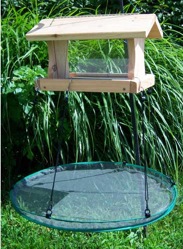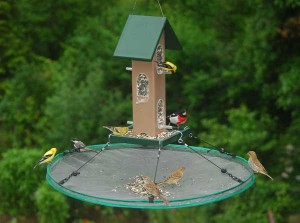-
hawk finds a finch bird feeder the perfect perch
He sits, waits and watches, almost on a daily basis for the past few weeks. This guy is huge too, a Sharp Shinned Hawk on the prowl for a quick meal, and pickin’s are good in a yard where there’s lots of feeders and birdbaths. The call is blood-curdling prior to landing, all songbirds scatter… fast! Luckily there’s also good cover for protection from such predators, but one must be be quick!
Lately he’s been perching on the finch bird feeder, a good central spot offering spanning views of the yard and unassuming victims. Last week when I looked out, there were actually two hawks, (a double omg!) so one must be a juvenile. They’re so darn big it’s hard to tell!
The last few days I haven’t seen them, but have witnessed strange behavior from the Blue Jays. They’re screaming wildly and loud, almost as if to mimic the hawks. Someone once mentioned Jays will do this to keep hawks away. Well, if that’s the case, then bravo to these smart birds who some find to be a nuisance.
By the way, this feeder is fitted with a 30″ Seed Hoop which catches waste and attracts some other birds who never use the feeder itself.
-
Got rat problems? Use seed catchers and quality bird seed
If you’ve ever seen rats crawling around the ground beneath bird feeders, they’re just looking for a meal, even though it’s enough to make your own skin crawl!
Spilled seed is a major attractant of rats and other unwanted guests, in rural and especially in urban areas. The first reaction is usually: “Oh no, I have to stop feeding the birds now.” Not true!
There are some fairly simple methods to stopping the madness. One is to use seed catchers or seed trays which prevent spilled seed in the first place. The large platform area of some seed trays will attract new birds who have never used the feeder.
Another way to avoid these unwanted guests while still feeding your birds is to feed a high quality seed. Less expensive seed mixes contain fillers like millet, and finely cracked corn. Birds will continually toss these seeds out in search of the good stuff. So why not just feed the good stuff to start with? Black Oil Sunflower is a great basic seed preferred by many species. An even better choice is the Sunflower Hearts or Meats. There’s absolutely no waste, no shells, no mess. It does cost more, but again… there’s no waste, so it’s almost a wash. Nothing wasted on the ground for scouring rats, opossums, or raccoons, because all of the seed is consumed by your avian amigos!
Suet is another good choice because there’s no waste, no mess. Specialty mixes (doughs) are even meant for summer feeding. Some of the more common, or fat-based suet formulas may sour and turn rancid in summer’s extreme temperatures. But the heat will not affect suet doughs…. and both resident and migratory birds devour this stuff!
Below is a real note from one of our repeat customers, just yesterday. She phoned with some questions and had planned to purchase two seed trays. After speaking with her, the plans changed: (proof positive the above content holds some weight)
“thanks for chatting with me yesterday about seed catchers for my bird feeders. I am going to hold off on buying and change the birdseed instead to shelled sunflower nuts. I did go look outside and indeed there is a lot of millet on the ground, along with sunflower shells. I’m hoping this will work, if not I will order the seed catchers!
Thanks,
Judy”By the way, the seed catcher shown above is adjustable. It fits just about any feeder and comes in two diameters; 16 and 30-inch. The larger “SeedHoop” may even be pole mounted by creating a slit in the center of the tray. They’re versatile, durable, and best of all… they work!
-
Seed Catchers promote healthier birds
When spilled birdseed sits on the ground for a few days, it gets nasty. Combine that with some rain and warmer temperatures, (like we’ve been having in the south) and you get insta-mold. That’s my word for quickly-molding, bacteria producing, old seed. Ground feeding birds like some sparrows, juncos and even cardinals will forage through this nasty stuff looking for a decent bite to eat. Thus, bacteria and germs are spread amongst your backyard birds. The result is usually a respiratory infection and many time turns into conjunctivitis. In birds, this disease is usually fatal.
Aside from keeping feeders themselves clean, it’s important to be aware of the entire feeding area, including the ground below your bird feeders. Seed Catchers greatly reduce spilled seed, while keeping the appearance of your yard nicer. Eliminating the ground mess below feeders really does promote healthier birds.
The large seed catcher shown here features an adjustable and innovative design. Known as the Seed Hoop, it works virtually with any bird feeder, whether hanging or pole-mounted. Available in a 16-inch diameter, it accommodates most tube-style feeders, even those hung on a shepherd’s hook. The larger 30-inch diameter may actually be pole-mounted below the feeder by cutting a slit in the center of the seed tray. If this is the desired use, it’s best to place some duct tape around the slit, and here’s why: We’ve had the 30-inch seed catcher installed on the pole itself with a finch feeder above. Over several months, this center hole has gotten larger from removing and replacing the tray for cleaning. Besides… duct tape fixes everything, right?



